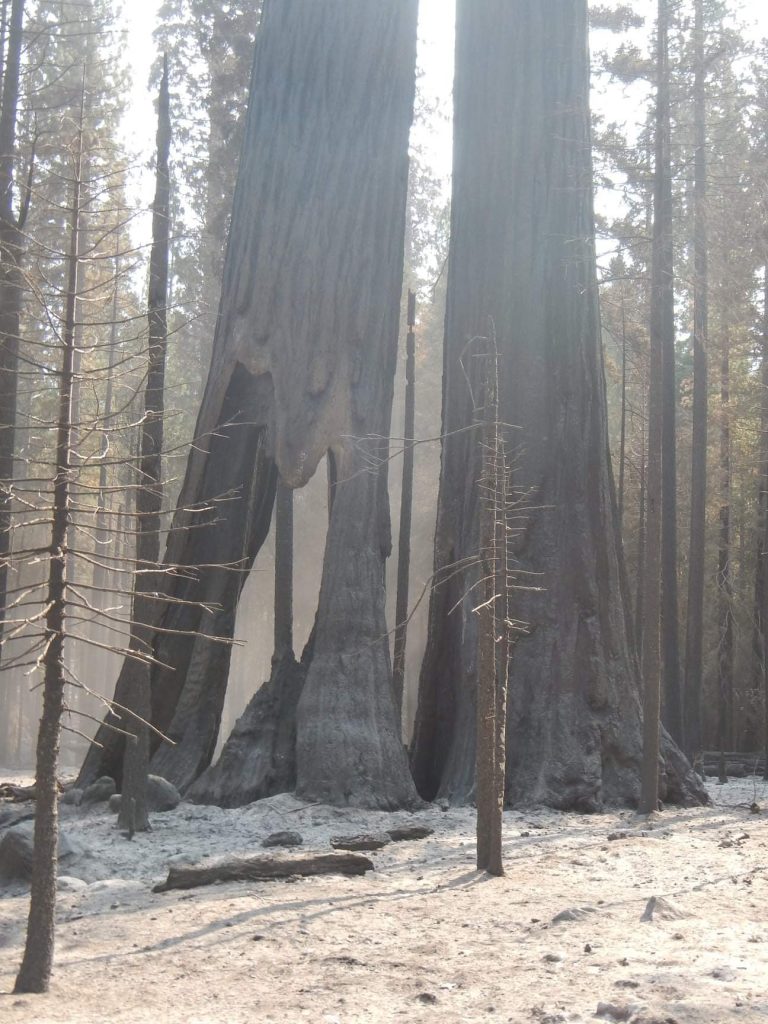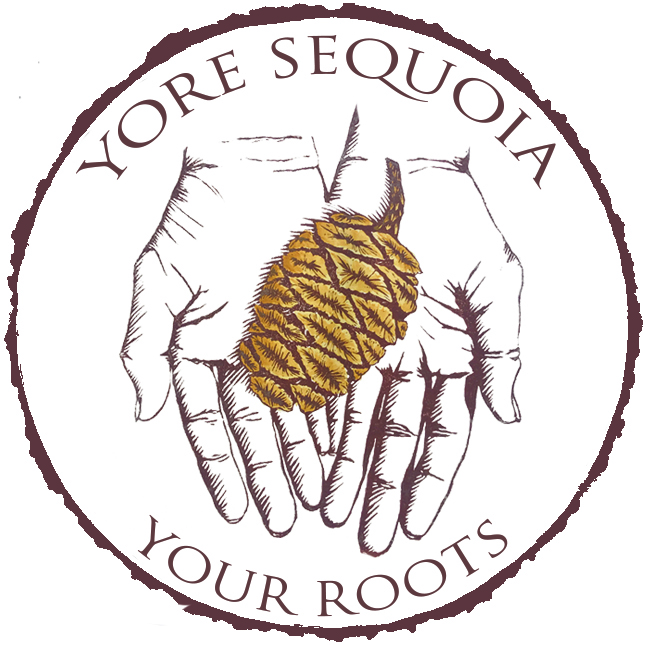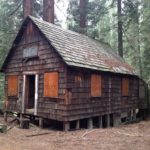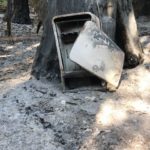
Big trees and historic cabins were 2020 Castle Fire casualties in Sequoia’s Dillonwood Grove.
By Sarah Elliott and Laile Di Silvestro for 3RNews, 6 November 2020.
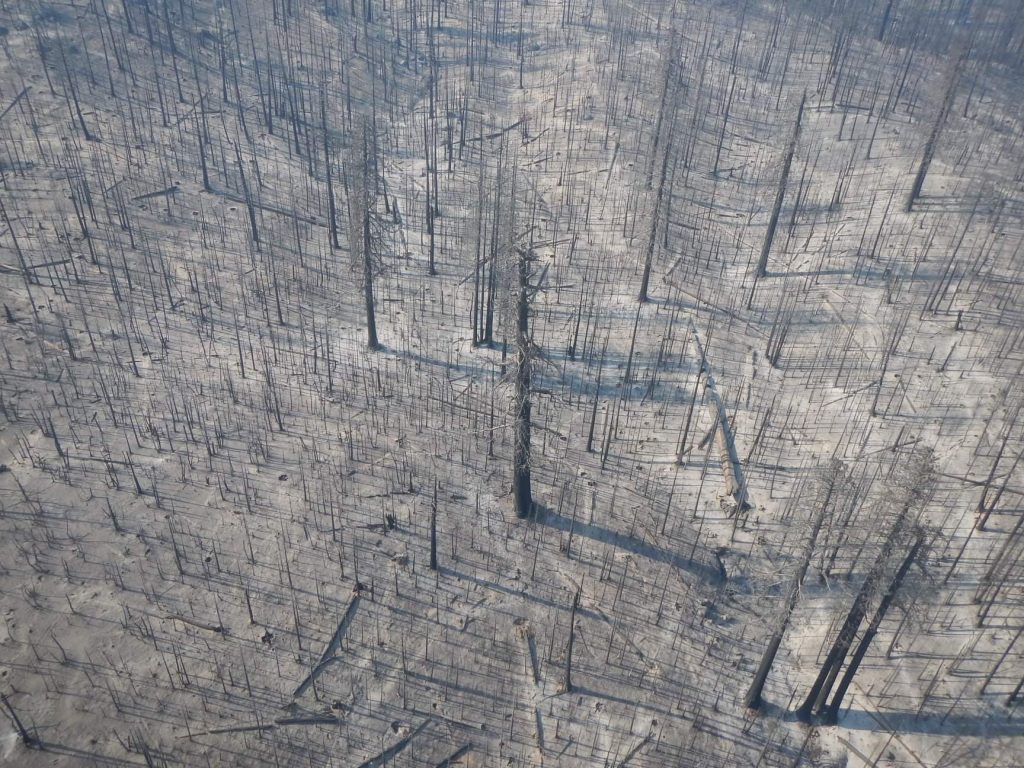
The Dillonwood Grove of giant sequoias, at one time the largest privately owned stand of giant sequoia trees, is located 32 miles from Highway 198’s intersection with Yokohl Valley Road and 6 miles north of Balch Park. Although within an easy day trip of Three Rivers, the grove is the least visited area of Sequoia National Park that is accessible by road. A high-clearance vehicle is necessary to traverse the severely rutted, previously overgrown (but now the vegetation has burned), narrow access road, then it’s several more miles of hiking once the locked entrance gate is reached.
From logging to preservation
Logging started on the lower fringes of Dillonwood around 1865 and continued sporadically until about 1990. In 2001, Save the Redwoods League donated the 1,540-acre grove containing multi-generational giant sequoias to Sequoia National Park after a massive fundraising campaign to purchase the privately held grove. Big Trees and historic cabins
The nonprofit organization brokered a deal to purchase the grove to remove it from private hands and the threat of logging. The purchase price was $10 million. The League raised $5 million to match a $5 million grant approved by Congress that came from the federal Land and Water Conservation Fund.
At the time, Dillonwood Grove was owned by siblings David Reed and Susan Matthews, who inherited the land in the mid 1980s. Their parents, Forrest Reed, a professional forester, and Ruth Moore Reed, whose father worked for Pacific Lumber Company in Humboldt County, bought the land in 1960.

Giant sequoias and their nemeses
During a century or more of logging in the grove, many old-growth sequoias were felled. All but about 100 large giant sequoias were cut. But it was currently a thriving grove with subsequent generations of sequoias growing where their ancestors were cut and hauled away. And while logging will never occur again in the remote Dillonwood Grove, these Big Trees were recently confronted with another threat: high-severity fire. Big Trees and historic cabins
Even the oldest, largest giant sequoias are vulnerable to intense fire. Most of these ancient trees — at the headwaters of the North Fork of Tule River and bounded on three sides by Giant Sequoia National Monument — have lived through hundreds of fires since before the birth of Jesus Christ, yet modern wildfires are killing them. And while some giant sequoia seedlings will germinate after the fire, new seedlings will have difficulty competing with the shrubs that flourish in response to high-severity fire.
Historic structures decimated
Left over from the Dillonwood logging days were some wooden structures that are now gone. Click on the before-and-after photos below to witness the destruction.
Two other historic cabins in other areas of the Golden Trout Wilderness were destroyed. The Mountain Home Guard Station was built by the Civilian Conservation Corps, ca. 1937-1938, and was in use recently as a recreational rental. The Grey Meadow Guard Station was completed in 1916 for a total construction cost of $90.
Dillonwood’s namesake
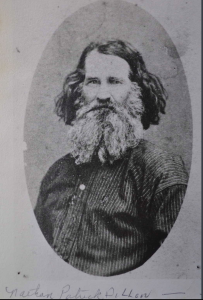
Nathaniel Patrick Dillon (1820-1903) was one of the earliest Euro-American settlers in Tulare County. He arrived in 1853 with a few siblings, his wife Zylpha, and three children, one of whom was born en route. They initially entered into the incipient livestock industry and grew grain.
At some point in the 1860s, however, Nathan got into the milling business. His initial mills were gristmills, which converted the area’s corn and wheat into flour and made him one of the most wealthy men in the area.
Zylpha and Nathan had at least 12 children, nine of whom survived into adulthood. They also cared for Elliott and Mary Jane Dillon, the children of Nathan’s younger brother Peter Ewell, who were orphaned in 1866. After Zylpha died in 1886, Nathan remarried and had one more child before his second wife died after being thrown from a wagon while descending the mountain from Dillonwood.
Dillonwood was Nathan’s pinery, which he established in 1875. It is believed to have been his second lumber mill, the first having been established the prior year in Mineral King in the area now known as Faculty Flat. Nathan did not engage in mining in Mineral King, but instead panned for gold in the White River area, founded in 1856 as a gold camp. Originally called Dogtown, then Tailholt, the unincorporated Tulare County community is known today as White River. It is located about 10 miles east of Delano.
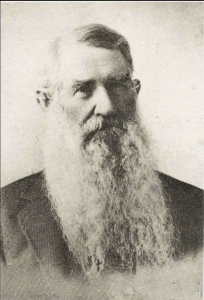
Members of the Dillon family did stake Mineral King mine claims, however, and Dillonwood served as a wayside during the 1870s and 1880s for miners and adventurers traveling from the Tule River country to Mineral King. At one time, there were plans for the route from Dillonwood to be the main route to Mineral King.
One of the Mineral King miners was Nathan’s adopted niece Mary Jane Dillon, who staked a claim with Anna Mills shortly before Mary Jane was to marry Samuel Miles Gilliam (brother-in-law of Mineral King resort owner Arthur Crowley). Anna Mills was one of the most famous people to camp at Dillonwood. She did so in 1878 while on her way to climb Mount Whitney with the first party of women to reach the summit.
By the end of his life, Nathan was blind. However, his children tended him as well as his land.
Laile Di Silvestro of Three Rivers, historical archaeologist, provided the background on Nathaniel Dillon.
Castle Fire and the sequoia groves in its path
The 2020 Castle Fire burned an estimated 13,600 acres in 10 giant sequoia groves that are located within the Giant Sequoia National Monument of the Sequoia National Forest. Sequoia National Forest has 33 groves total within its boundaries. The Forest Service groves impacted were Alder Creek (shared with private landowner), Mountain Home (shared with State of California), Belknap Complex (McIntyre, Wheel Meadow, Belknap; shared with private landowner), Dillonwood (shared with National Park Service), Middle Tule (shared with State of California), Burro Creek, Freeman Creek, Silver Creek, Upper Tule, and Wishon groves.
Approximately 9,800 acres (35%) burned out of the 27,830 acres of giant sequoia groves in the Monument, with approximately 6,000 acres (61%) burning at high-severity. Where fire burned at lower-severity, or where high-severity patches were small, the fire is expected to have restorative effects on the groves by activating sequoia seedling growth, reducing fuel loads that could fuel future fires, and clearing out small trees leaving more water and light available for remaining plants and sequoia seedlings.
Giant sequoias are a fire-adapted species and need fire to regenerate. Forest fuels in many groves have dramatically changed from fire exclusion and the presence of drought-killed trees of other species, which influences how severely wildfire moves through them. Patches of high-severity fire in the 2020 Castle Fire were likely much larger than they would have been historically, and this could mean an uncertain future for portions of the groves.
The Forest Service will not be able to assess grove impacts until a thorough survey can be conducted. Preliminary satellite data indicate the highest losses of mature giant sequoia trees are in the Belknap Complex and the Freeman Creek groves. Of the recently burned groves, the U.S. Forest Service Burned Area Emergency Response Team found that Alder Creek, Belknap Complex, Dillonwood, and Freeman Creek groves burned at the highest severity, which implies there were also higher losses of trees in those groves.
Note: This article does not include an assessment of the impacts of the Castle Fire on giant sequoia groves within Sequoia National Park. In addition to Dillonwood, nine other sequoia groves in the park are within the Castle Fire’s perimeter: Garfield, Devils Canyon, Forgotten, Clough Cave, Putnam-Francis, South Fork, Cedar Flat, Board Camp, and Homers Nose groves.
